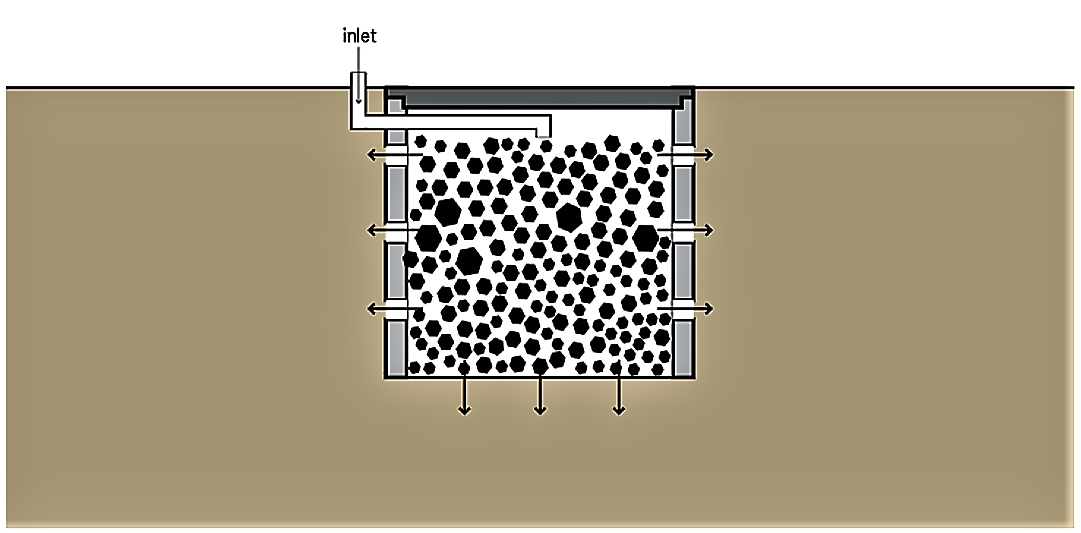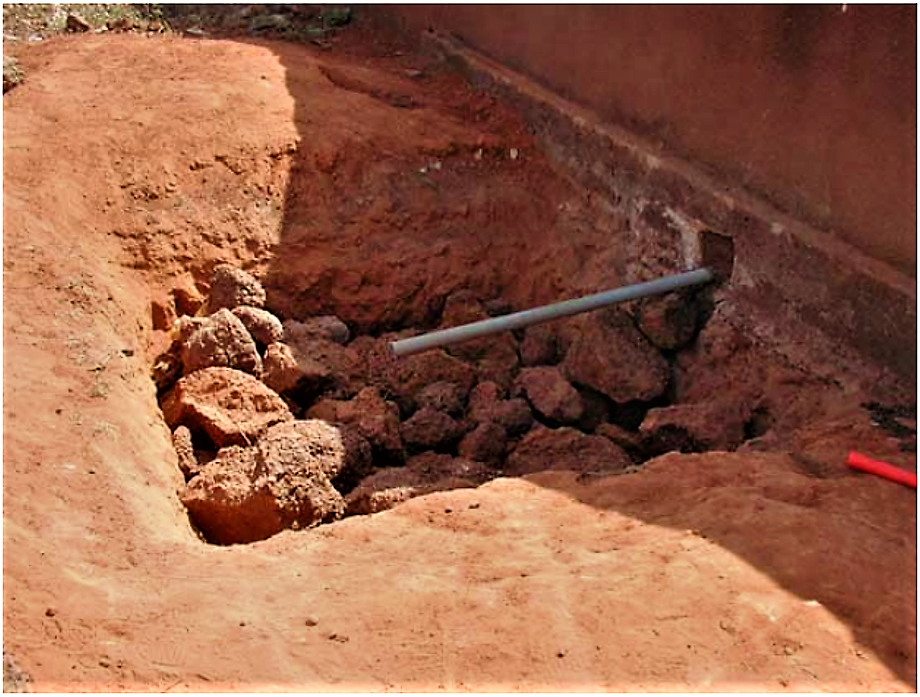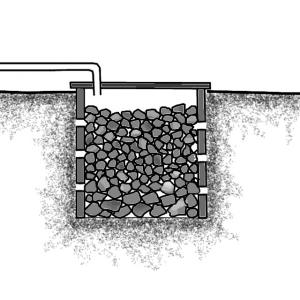A soak pit, also known as a soakaway or leach pit, is a covered, porous-walled chamber that allows water to slowly soak into the ground. Pre-settled effluent from a collection and storage/treatment or (semi-) centralized treatment technology is discharged to the underground chamber from which it infiltrates into the surrounding soil.
| المُدخلات | المُخرَجات |
|---|---|
Precipitation, Greywater, Fertigation Water, Effluents from On-site Pre-settling Units |
- |
If there is no intention or no need to reuse wastewater, collected stormwater or greywater, soak pits can offer a cost-efficient opportunity for a partial treatment of waste- grey- or stormwater from a primary treatment (e.g. septic tank, twin-pits for pour-flush toilets, biogas settler, anaerobic baffled reactor, etc.) and a relatively safe way of discharging it to the environment and therewith recharging groundwater bodies. As wastewater (greywater or blackwater after primary treatment) percolates through the soil from the soak pit, small particles are filtered out by the soil matrix and organics are digested by microorganisms. The wastewater effluent is absorbed by soil particles and moves both horizontally and vertically through the soil pores. Sub-soil layers should therefore be water permeable in order to avoid fast saturation. High daily volumes of discharged effluents should be avoided (HEEB et al. 2008). Thus, soak pits are best suited for soil with good absorptive properties; clay, hard packed or rocky soil is not appropriate. Soak pits are used the same way as leach fields, but require less space as well as less operation and maintenance. But they generally can also receive less influent and the groundwater pollution may be higher than with leach fields.
The soak pit , consisting basically of a simple pit (generally approximately 1 m3), should be between 1.5 and 4 m deep, but as a rule of thumb, never less than 2 m above the groundwater table. It should be located at a safe distance from a drinking water source (ideally more than 30 m). The soak pit should be kept away from high-traffic areas so that the soil above and around it is not compacted. It can be left empty and lined with a porous material to provide support and prevent collapse, or left unlined and filled with coarse rocks and gravel. The rocks and gravel will prevent the walls from collapsing, but will still provide adequate space for the wastewater. In both cases, a layer of sand and fine gravel should be spread across the bottom to help disperse the flow. To allow for future access, a removable (preferably concrete) lid should be used to seal the pit until it needs to be maintained.

As long as the soak pit is not used for raw sewage, and as long as the previous collection and storage/treatment technology is functioning well, health concerns are minimal. The technology is located underground and, thus, humans and animals should have no contact with the effluent. It is important however, that the soak pit is located at a safe distance from a drinking water source (ideally at least 30 m).
Since the soak pit is odourless and not visible, it should be accepted by even the most sensitive communities.
A well-sized soak pit should last between 3 and 5 years without maintenance. To extend the life of a soak pit, care should be taken to ensure that the effluent has been clarified and/or filtered to prevent the excessive build-up of solids.

The soak pit should be kept away from high-traffic areas so that the soil above and around it is not compacted. Particles and biomass will eventually clog the pit and it will need to be cleaned or moved. When the performance of the soak pit deteriorates, the material inside the soak pit can be excavated and refilled.
To allow for future access, a removable (preferably concrete) lid should be used to seal the pit until it needs to be maintained.
A soak pit does not provide adequate treatment for raw wastewater and the pit will quickly clog. It should be used for discharging pre-settled blackwater or greywater.
Soak pits are appropriate for rural and peri-urban settlements. They depend on soil with a sufficient absorptive capacity , whereas clay soils as well as hard packed or rocky soils are not appropriate . They can be used in almost every temperature, although there may be problems with pooling effluent in areas where the ground freezes. They are not appropriate for areas prone to flooding or that have high groundwater tables and should be constructed in a distance of at least 30 m from drinking water wells in order to prevent cross-contamination .
A Comparison of Wash Area and Soak Pit Construction
This Master Thesis describes the implementation of a soak pit and a wash area in a rural area next to the city Sikasso in West Africa. This detailed report describes how to built and how to dimension a soak pit and covers also social, technical and economic aspects.
AHRENS, B. (2005): A Comparison of Wash Area and Soak Pit Construction. The Changing Nature of Urban, Rural, and Peri-Urban Linkages in Sikasso, Mali (Master Thesis). Michigan Technological University URL [Accessed: 23.02.2010]Ecosan Curriculum 2.3
Low-cost Urban Sanitation
This book covers the public health, technical, socioeconomic, sociocultural and institutional aspects of sanitation in towns and cities of developing countries. The text features excreta-related diseases and the use of sanitation to reduce their transmission. The sanitation technologies covered in detail are VIP latrines, pour-flush toilets, septic tanks, settled sewerage and simplified sewerage, with additional chapters on sullage disposal, pit emptying, and sewage treatment and reuse. Sociocultural constraints on sanitation systems and their socioeconomic costing are described, together with hygiene education, which is essential in order to achieve maximum benefits to health. The text also explains how to choose the most appropriate sanitation option for a given low-income community. Finally, institutional aspects are reviewed, including effective sanitation programme planning, monitoring and evaluation.
MARA, D. (1996): Low-cost Urban Sanitation. United Kingdom: WileySeptic Tank Guidelines
This document on septic tanks gives guidelines on how to design and make a system.
OXFAM (2008): Septic Tank Guidelines. (= Technical Brief ). Oxford: OXFAM URL [Accessed: 08.04.2014]Disposal of septic tank effluent
This paper presents a review on the septic tank and septic systems. Information on design and functional aspects, and environmental effects of septic tank systems are presented. Chapter 6.2 is about the disposal of septic tank effluent.
POLPRASERT, C. RAJPUT, V.S. (1982): Disposal of septic tank effluent. المُدخلات: POLPRASERT, C. ; RAJPUT, V.S. ; (1982): Septic Tank and Septic Systems. Bangkok: 31-58. URL [Accessed: 14.04.2014]Compendium of Sanitation Systems and Technologies. 2nd Revised Edition
This compendium gives a systematic overview on different sanitation systems and technologies and describes a wide range of available low-cost sanitation technologies.
TILLEY, E. ULRICH, L. LUETHI, C. REYMOND, P. ZURBRUEGG, C. (2014): Compendium of Sanitation Systems and Technologies. 2nd Revised Edition. Duebendorf, Switzerland: Swiss Federal Institute of Aquatic Science and Technology (Eawag) URL [Accessed: 28.07.2014] PDFCompendium of Sanitation Systems and Technologies (Arabic)
This is the Arabic version of the Compendium of Sanitation Systems and Technologies. The Compendium gives a systematic overview on different sanitation systems and technologies and describes a wide range of available low-cost sanitation technologies.
TILLEY, E. ULRICH, L. LUETHI, C. REYMOND, P. SCHERTENLEIB, R. ZURBRUEGG, C. (2014): Compendium of Sanitation Systems and Technologies (Arabic). 2nd Revised Edition. Duebendorf, Switzerland: Swiss Federal Institute of Aquatic Science and Technology (Eawag) PDFLow-cost Urban Sanitation
This book covers the public health, technical, socioeconomic, sociocultural and institutional aspects of sanitation in towns and cities of developing countries. The text features excreta-related diseases and the use of sanitation to reduce their transmission. The sanitation technologies covered in detail are VIP latrines, pour-flush toilets, septic tanks, settled sewerage and simplified sewerage, with additional chapters on sullage disposal, pit emptying, and sewage treatment and reuse. Sociocultural constraints on sanitation systems and their socioeconomic costing are described, together with hygiene education, which is essential in order to achieve maximum benefits to health. The text also explains how to choose the most appropriate sanitation option for a given low-income community. Finally, institutional aspects are reviewed, including effective sanitation programme planning, monitoring and evaluation.
MARA, D. (1996): Low-cost Urban Sanitation. United Kingdom: WileyHow to Select Appropriate Technical Solutions for Sanitation
The purpose of this guide is to assist local contracting authorities and their partners in identifying those sanitation technologies best suited to the different contexts that exist within their town. The first part of the guide contains a planning process and a set of criteria to be completed; these assist you in characterizing each area of intervention so that you are then in a position to identify the most appropriate technical solutions. The second part of the guide consists of technical factsheets which give a practical overview of the technical and economic characteristics, the operating principle and the pros and cons of the 29 sanitation technology options most commonly used in sub-Saharan Africa.
MONVOIS, J. GABERT, J. FRENOUX, C. GUILLAUME, M. (2010): How to Select Appropriate Technical Solutions for Sanitation. (= Six Methodological Guides for a Water and Sanitation Services' Development Strategy , 4 ). Cotonou and Paris: Partenariat pour le Développement Municipal (PDM) and Programme Solidarité Eau (pS-Eau) URL [Accessed: 19.10.2011]Disposal of septic tank effluent
This paper presents a review on the septic tank and septic systems. Information on design and functional aspects, and environmental effects of septic tank systems are presented. Chapter 6.2 is about the disposal of septic tank effluent.
POLPRASERT, C. RAJPUT, V.S. (1982): Disposal of septic tank effluent. المُدخلات: POLPRASERT, C. ; RAJPUT, V.S. ; (1982): Septic Tank and Septic Systems. Bangkok: 31-58. URL [Accessed: 14.04.2014]Compendium of Sanitation Systems and Technologies. 2nd Revised Edition
This compendium gives a systematic overview on different sanitation systems and technologies and describes a wide range of available low-cost sanitation technologies.
TILLEY, E. ULRICH, L. LUETHI, C. REYMOND, P. ZURBRUEGG, C. (2014): Compendium of Sanitation Systems and Technologies. 2nd Revised Edition. Duebendorf, Switzerland: Swiss Federal Institute of Aquatic Science and Technology (Eawag) URL [Accessed: 28.07.2014] PDFA Comparison of Wash Area and Soak Pit Construction
This Master Thesis describes the implementation of a soak pit and a wash area in a rural area next to the city Sikasso in West Africa. This detailed report describes how to built and how to dimension a soak pit and covers also social, technical and economic aspects.
AHRENS, B. (2005): A Comparison of Wash Area and Soak Pit Construction. The Changing Nature of Urban, Rural, and Peri-Urban Linkages in Sikasso, Mali (Master Thesis). Michigan Technological University URL [Accessed: 23.02.2010]Septic Tank Guidelines
This document on septic tanks gives guidelines on how to design and make a system.
OXFAM (2008): Septic Tank Guidelines. (= Technical Brief ). Oxford: OXFAM URL [Accessed: 08.04.2014]Ecosan Curriculum 2.3
http://www.epd.gov.hk/epd/english/environmentinhk/waste/guide_ref/guide_lwc_scheme_sub6_ss5.html
On the website of the Hong Kong Environmental Protection Department, guidelines for soakaway systems are published.


